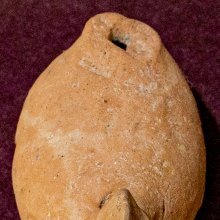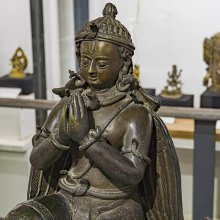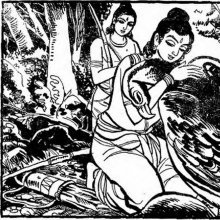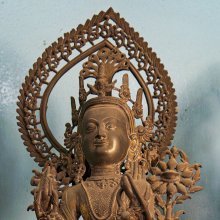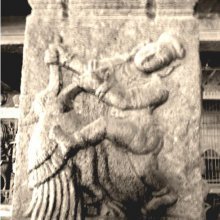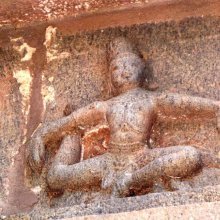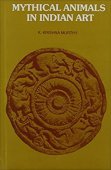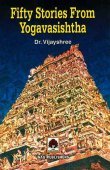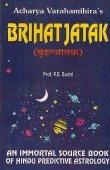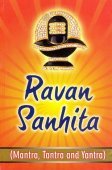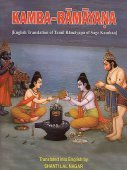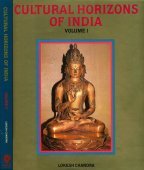Bird: 4 definitions
Introduction:
Bird means something in Buddhism, Pali, Hinduism, Sanskrit, the history of ancient India. If you want to know the exact meaning, history, etymology or English translation of this term then check out the descriptions on this page. Add your comment or reference to a book if you want to contribute to this summary article.
Images (photo gallery)
(+22 more images available)
In Hinduism
Natyashastra (theatrics and dramaturgy)
Source: Shodhganga: Elements of Art and Architecture in the Trtiyakhanda of the Visnudharmottarapurana (natya)Birds (like Cakora and Cātaka) are associated with Kāṅgūla-hasta: one of the twenty-two Single-hand Gestures (in Indian Dramas) (known as asaṃyuktahastas), according to the Viṣṇudharmottarapurāṇa, an ancient Sanskrit text which (being encyclopedic in nature) deals with a variety of cultural topics such as arts, architecture, music, grammar and astronomy.—In kāṅgūlahasta, the middle finger is set between the forefinger and thumb while the ring finger is bent and the little finger is quite upward. According to the Viṣṇudharmottarapurāṇa, the kāṅgūla posture is used to denote fruits. In the Abhinayadarpaṇa, this posture is said to indicate things as fruits, bell, birds like cakora and cātaka, coconut etc.

Natyashastra (नाट्यशास्त्र, nāṭyaśāstra) refers to both the ancient Indian tradition (shastra) of performing arts, (natya—theatrics, drama, dance, music), as well as the name of a Sanskrit work dealing with these subjects. It also teaches the rules for composing Dramatic plays (nataka), construction and performance of Theater, and Poetic works (kavya).
Yoga (school of philosophy)
Source: ORA: Amanaska (king of all yogas): A Critical Edition and Annotated Translation by Jason BirchThe Bird (symbolizing the Mind) is denoted by the Sanskrit term Manaḥ-Pakṣī, according to the Amanaska Yoga treatise dealing with meditation, absorption, yogic powers and liberation.—Accordingly, as Īśvara says to Vāmadeva: “[...] When the wings, which are the in and out breaths and whose sphere of operation is all the senses, are cut off, the mind-bird (manaḥ-pakṣī) being motionless [in the air], plummets. [The Yogin] becomes joyful like a fish having torn [free from] the mind-net, whose threads are the breath and whose knots are the senses. [...]”.

Yoga is originally considered a branch of Hindu philosophy (astika), but both ancient and modern Yoga combine the physical, mental and spiritual. Yoga teaches various physical techniques also known as āsanas (postures), used for various purposes (eg., meditation, contemplation, relaxation).
In Buddhism
Tibetan Buddhism (Vajrayana or tantric Buddhism)
Source: ORA: Amanaska (king of all yogas): (Tibetan Buddhism)Birds (in Sanskrit: Pakṣin) can be controlled by one having the Siddhi (power) of Speech, according to verse 14.24bd-27 of the Laghuśaṃvara, an ancient Buddhist Yoginī Tantra.—Accordingly: “The Sādhaka [who has] the Siddhi of speech can certainly attract a king or queen by [merely] thinking [it]. [...] And he can stop a river, a cart, a machine [like a water-wheel,] the ocean, elephants and horses, clouds, a man or bird (pakṣin) [pakṣiṇam] merely by means of his speech. He achieves everything which he desires by his speech”.

Tibetan Buddhism includes schools such as Nyingma, Kadampa, Kagyu and Gelug. Their primary canon of literature is divided in two broad categories: The Kangyur, which consists of Buddha’s words, and the Tengyur, which includes commentaries from various sources. Esotericism and tantra techniques (vajrayāna) are collected indepently.
India history and geography
Source: Singhi Jain Series: Ratnaprabha-suri’s Kuvalayamala-katha (history)1) Birds were kept as pets, and put in cages as part of the tasks performed to beautify the Sleeping chamber (of young ladies) in Ancient India, as depicted in the Kathās (narrative poems) such as Uddyotanasūri in his 8th-century Kuvalayamālā (a Prakrit Campū, similar to Kāvya poetry).—The Kuvalayamala (779 A.D.) is full of cultural material which gains in value because of the firm date of its composition. [...] Page 83.3-9: Here is the description of the house or the sleeping chambers of young ladies which were beautified for the reception of their husbands. The select items in this list are as follows: [e.g., placing the pet birds in the cages (jaṃta-sauṇae);] [...]
2) Birds (and other animal life) was commonly depicted on the Saṃsāracakra paintings (representing scenes of animal life), in ancient India, according to the Kuvalayamālā.—Page 185.21 f.: Here follows a description of a printed scroll illustrating the Jaina conception of saṃsāracakra. [...] The saṃsāra-cakra illustrated the three worlds of hell, human world and the world of gods. [For example:] Scenes of bird and animal life, e.g., fight between lion and elephant (as depicted in the Kailāsa temple at Ellora).

The history of India traces the identification of countries, villages, towns and other regions of India, as well as mythology, zoology, royal dynasties, rulers, tribes, local festivities and traditions and regional languages. Ancient India enjoyed religious freedom and encourages the path of Dharma, a concept common to Buddhism, Hinduism, and Jainism.
See also (Relevant definitions)
Starts with (+11): Bird cactus, Bird catcher tree, Bird catching tree, Bird cherry, Bird flower, Bird killer tree, Bird knotgrass, Bird knotweed, Bird of paradise flower, Bird plum, Bird vine, Bird-berry, Bird-lime, Bird-lime tree, Bird-nest, Bird-of-paradise, Bird-on-the-wing, Birdbill dayflower, Birdflower, Birdfoot violet.
Ends with: Black bird, Pet bird, Vegetable hummingbird.
Full-text (+4608): Pakshin, Shakuna, Garuda, Vishkira, Cakora, Vihaga, Sharika, Tittibha, Khaga, Shakunika, Hamsa, Shakunta, Andaja, Patatrin, Shakunti, Vitamsa, Suparṇa, Pratuda, Sakuntika, Troti.
Relevant text
Search found 388 books and stories containing Bird; (plurals include: Birds). You can also click to the full overview containing English textual excerpts. Below are direct links for the most relevant articles:
The Great Chronicle of Buddhas (by Ven. Mingun Sayadaw)
(Mark 28): The Mark of the Voice having Eight Qualities as a Brahmā < [Chapter 1 - The Story of Sataketu Deva, The Future Buddha]
Discourse on Kuṇāla Jātaka < [Chapter 22 - Founding of Vesali]
Part 2 - The Story of Prince Bodhi < [Chapter 26 - The Buddha’s Eighth Vassa at the Town of Susumaragira]
The Mahavastu (great story) (by J. J. Jones)
Chapter XXIII - Jātaka of the Bird (Śakuntaka) < [Volume II]
Chapter XXVI - Jātaka of the Bird (Śakuntaka) (2) < [Volume II]
Chapter XXVII - Jātaka of the Three Birds < [Volume I]
Puranic encyclopaedia (by Vettam Mani)
Kathasaritsagara (the Ocean of Story) (by Somadeva)
Note on mounting giant birds < [Notes]
Note on the Garuḍa bird < [Notes]
The motif of overhearing conversations < [Notes]
Charaka Samhita (English translation) (by Shree Gulabkunverba Ayurvedic Society)
Chapter 27c - The group of meats (Mamsa) < [Sutrasthana (Sutra Sthana) — General Principles]
Chapter 29 - The Ten Resorts of Life (Dasha-Prana-Ayatana) < [Sutrasthana (Sutra Sthana) — General Principles]
Chapter 12 - The remaining best kinds of Enema (uttara-basti-siddhi) < [Siddhisthana (Siddhi Sthana) — Section on Successful Treatment]
Brihat Samhita (by N. Chidambaram Iyer)
Related products
(+3 more products available)
